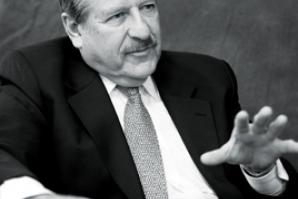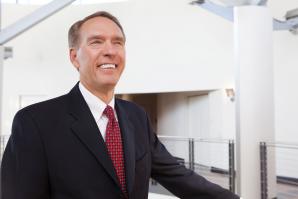Sacramento State President Alexander Gonzalez’s tenure has been one of the most tumultuous in the university’s history.
Since coming to the campus in 2003, he has faced historic budget challenges and constant conflict with faculty and staff, much of it in regard to the Destination 2010 program, his signature effort to transform Sacramento State into a marquee metropolitan university. For all the struggle, Gonzalez has also been remarkably successful, most notably in getting students to sign off on raising their own fees to help fund the school’s makeover.
We sat down with him recently to discuss that effort and the university’s future.
Comstock’s: In your fall address to the university staff
and faculty, you said you were approaching the future with
“cautious optimism.” What do you mean by that?
Gonzalez: The environment for higher education has more
questions than answers. I think we’re at a point where the public
has to recommit to public higher education. The reductions in
budget and the lack of support over the past several years really
does raise the question: Is a public higher education going to be
affordable, accessible and still provide that level of quality
that we’ve had in the past, or is it going to be driven by demand
and cost and who can afford it? I’m optimistic that, in
California, we still have the best system, especially the CSU,
but this is the first year in the 32 years that I’ve been in the
system where we’ve actually turned away students who were
qualified because we had a cap on enrollment. If you look at the
history of the CSU, that’s pretty scary. So that’s why I say I’m
cautiously optimistic.
Comstock’s: You came to the university in 2003 with
ambitious goals, notably the Destination 2010 effort. How would
you assess that effort today?
Gonzalez: Anyone who lives here knows the impact and
influence of politics on everything that goes on in Sacramento.
Destination 2010 to me was a very simple initiative and, in a
sense, its simplicity was kind of valiant. Four cornerstones:
having excellent academics and student programs, making a
welcoming campus, creating a dynamic physical environment and
having community interaction and support. Looking back on it now,
I think we’ve achieved each one of those goals to some extent.
Academically, all students who enter Sacramento State now have to
go through mandatory orientation and advising, and we’ve added
one doctoral program, the EDD in education leadership, with the
potential for adding a couple more. Our nursing program is
hopefully going to double in size, and we’ve added our executive
MBA program, which has been very successful. The campus is also
very different now, with the electronic sign out on Highway 50
and banners all over the place so you can see where you are. We
also just opened up our fantastic recreation and wellness center.
Last year, we opened up our new student housing (certified gold
in the Leadership in Energy and Environmental Design program), a
new bookstore and parking structures. We have more upgrades
planned, especially our science building. It’s an old science
building with old equipment. You walk through there and wonder if
some of the stuff should be in a museum.
Comstock’s: The ride has not always been smooth, and
you’ve certainly had your share of issues with faculty and staff.
For instance, your critics say the science building upgrade
should have been done before the campus signage. Is that a fair
assessment?
Gonzalez: No, and it really is indicative of people on
the campus having no idea how the budget works. You can’t take
from one pot and put into another. Everything has to remain very
segregated between nonstate and state funding. What we’ve been
able to do here on the campus is all nonstate funding. The state
hasn’t had any capital program in years. The science building
would have been my No. 1 priority, but you have to use money from
the state for a capital project like that. You cannot use student
fees to build a classroom building.
Comstock’s: How would you assess your relationship with
faculty and staff now?
Gonzalez: I think it’s much improved. I think everybody
understands now everyone else’s role much more clearly. When the
faculty put up so much resistance, I think a lot of it was based
on, No. 1, a lack of information, and No. 2, propaganda on the
part of a relatively small group of faculty. Once I was able to
open the books and present that information, they realized what I
was telling them was exactly what was happening.
Comstock’s: There has been a growing push to add doctoral
programs to the California State University’s mission statement.
There has been concern that the approach has been too piecemeal,
focusing on specific programs one at a time rather than taking a
broad approach. What is the benefit of offering doctorate
programs, and what is the risk?
Gonzalez: The kind of doctoral programs we’re developing
in the [California State University system] are really the
applied programs, the kind the University of California really
hasn’t been supplying. The doctorate in educational leadership is
not research based; it’s an applied program. Before we developed
ours, most places that you could get an EDD were really expensive
private institutions. Our two additional programs are also
applied programs, the doctorate of applied nursing and the
doctorate of physical therapy. That’s being driven by the
industry. When I started teaching, a bachelor’s degree was all
you needed in physical therapy. Then it moved up to master’s. Now
it’s up to the doctorate.
Comstock’s: It sounds like you’re OK with these targeted
programs as opposed to the broad approach. What is the problem
with being broader?
Gonzales: Let’s take the sciences. Most of those are
going to be based out of research institutions, like the
University of California system, that have the infrastructure,
the grants, the resources and the faculty that are engaged in
research so they can take on graduate students that will work
with them. That’s part of the training. For those reasons, I
don’t think the state university system, and this campus in
particular, has the resources and money coming in to reach that
threshold. It doesn’t mean that we wouldn’t in the future, but I
don’t see the University of California relinquishing those at
all. That’s why the state system has focused on programs that are
applied and have a very specific target.
Comstock’s: So, do you have plans for another major
campus campaign, say a Destination 2020?
Gonzalez: We are engaged in something we call the
Futures Initiative, which began a year and a half ago. The first
phase was academic affairs and student affairs engaged together
with the university community in developing a strategic plan that
looks at our academic programs and what we’re going to do and how
we’re going to get there. We’ve also had some outside assessment,
and we’re now conducting a series of additional meetings to
identify what we want to do. I’m hoping that by the end of this
fall semester, or at the latest early spring, we’ll launch the
next initiative. So the answer in a long way is, stay tuned.
Recommended For You

President’s Circle
Sacramento State's Alex Gonzalez
Sacramento State President Alexander Gonzalez’s tenure has been one of the most tumultuous in the university’s history.

Head of the Class
A tenure of influence has run its course
For more than 40 years, Brice Harris has sat front row in the nation’s community college system. First as a part-time faculty member at a small campus in Kansas City, later as president of Fresno City College and since 1996 as chancellor of Los Rios Community College District. He has spent his career working within multi-college systems. This month, he retires.



